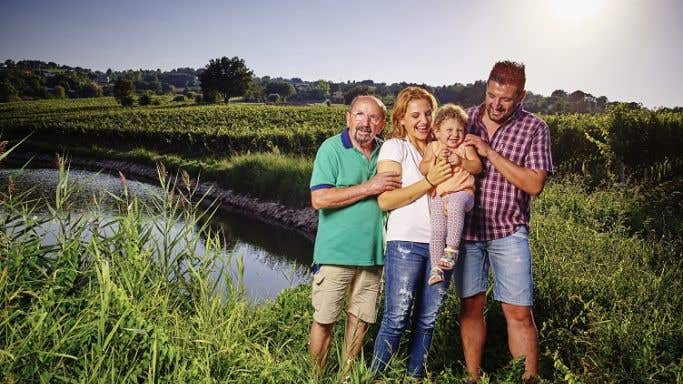From $11.99, €10, £14.95
Back in 2012, Walter wrote, with some feeling, a five-part series about disregarded Verdicchio and its need for a ‘total image makeover’. I visited the Marche in 2014 and came home with a new love in my life having seen, and tasted, Verdicchio in a whole new light. Throw the raciness of Riesling, the breadth of Chenin, and the seriousness of Chablis across a blank canvas and swirl – you’ll get Verdicchio: salty, powerful, intense, wire-cutter acidity, bitter almonds, cool citrus, and above all, the capacity to age into something quite extraordinary. Yet, despite the best efforts of wine writers and winemakers, Verdicchio persists in largely ignominious obscurity, its best-selling bottles made in industrial quantities for less than £7/$10 and tasting of watery apples. Not the kind of wines you’d be tempted to serve for dinner, let alone cellar for eight years.
Because good Verdicchio is still so hard to find, I had put this holiday romance out of my head and got on with the business of everyday life. And then I bumped into it again, unexpectedly, at a Lea & Sandeman tasting. It all came flooding back.
At first glance it barely caught my attention; pale, faint pear, faint almonds. In the mouth, to begin with, it was pure tension. The liquid version of a wire sculpture, glittering with acidity. But very quickly it began to build in the mouth, layering nuttiness with sweet lemon over zest and then sunflower seeds. Tension turned to intensity that lingered long after the wine had gone.
This wine, so delicious and intentional now, will get more complex and interesting with age. At each stage of its development it will be a brilliant food wine. While it’s young, think fresh spring green: peas and pea shoots, asparagus, dishes made with lots of fresh herbs, green pesto, lemon zest, ricotta and delicate seafood. As it ages it will be able to take richer dishes: pork belly with braised fennel, lobster, scallops in creamy dill sauce, a hard mountain cheese. Or you could sip it quite happily by itself, especially this young, because it’s so zesty. All this for less than £15. Ridiculously good value.
Andrea Felici started bottling his wines in 2002, but when his son Leopardo wanted to join the family firm, Andrea wisely sent him to get experience in the wider world, to develop a taste for fine wine, to broaden his perspectives before he came back to the tiny village of Apiro (population 2,430) in the Italian region of the Marche. Leo spent four years working as a sommelier, first for Gordon Ramsay at the Savoy Grill in London, and then for Giorgio Pinchiorri and Annie Féolde at the world-famous Enoteca Pinchiorri in Florence.
He returned home and with his father began to convert their 10 ha (25 acres) of vineyards, on hilly slopes at the foot of Mount San Vicino and surrounded by beautiful green woodland and mountains, to organic. This is a relatively cool region, 50 km (30 miles) from the Adriatic Sea and over 510 m (1,700 ft) above sea level. The breezes off the Adriatic are fresh, rain is plentiful, and the vines experience a wide diurnal temperature range of warm sunny days followed by very cool nights.

In 2016 spring was warm and dry, but summer oscillated between hot and cold and rainy, slowing ripening down and bringing a bit of botrytis, although that was arrested by very cool nights in early autumn. Grapes were picked in several passes through the vineyard from 20 September all the way through to mid October. This particular wine comes from a blend of their vineyards, from six-year-old and 35-year-old vines, on sandy clay. The younger vines are cuttings from old vines grafted onto new rootstocks. After a few days on skins, the must was fermented in stainless steel using natural yeast and some selected neutral yeasts, and spent three months on the lees. Filtering was kept to a minimum. The wine was aged for two months in bottle before release.

As is typical with Verdicchio, acidity is high (in this case TA is 6.5 g/l), despite being a slow, late-ripening variety with good sugars that can often translate to full-bodied, powerful wines with alcohols over 14%. In this case Leo has made a wine with beautiful restraint, at just 13%. He reckons that conservatively it will age for six years, although I am fairly confident that if you tucked this away until 2026, it will still be full of life and surprises. Just very different.
The Felici family made 60,000 bottles of this wine and you can buy it all over the US, the UK, Luxembourg, Italy, Belgium and Netherlands. Older vintages of the wine, 2012 to 2015, are available in Germany, Switzerland, Japan, Canada and the US. No one would be disappointed by an older vintage and the 2013 in particular comes from a very balanced, fresh year like 2016. In the UK the 2016 is sold by Lea & Sandeman and Sommelier’s Choice, and the 2015 by Latimer Vintners. If you get it from Lea & Sandeman as part of a case of 12, the price comes down to an even more affordable £13.50 a bottle.

